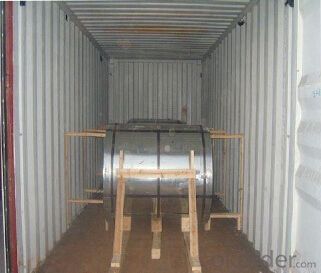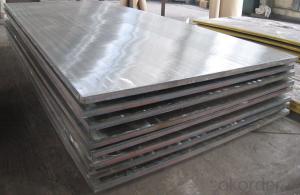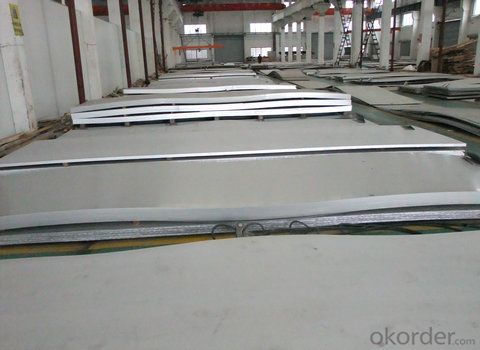Stainless Steel plate and sheet 316Ti with plenty stock
- Loading Port:
- Shanghai
- Payment Terms:
- TT OR LC
- Min Order Qty:
- 500 m.t.
- Supply Capability:
- 5000000 m.t./month
OKorder Service Pledge
OKorder Financial Service
You Might Also Like
Hot sale stainless steel sheet 201/202/304/304l/316/316l/430
Description of Stainless Steel Sheet:
Description | steel sheet,hot rolled steel sheet,cold rolled steel sheet, steel sheet,sheet,steel plate |
Standard | ASME, ASTM, EN ,BS,GB,DIN, JIS etc |
Application | Steel sheet applies to construction field, ships building industry, petroleum & chemical industries, war and electricity industries, food processing and medical industry, boiler heat exchanger, machinery and hardware fields. |
Packaging | Standard export sea-worthy packing |
Delivery time | 10-30 days |
Quality | No.1 |
Productivity | 500 tons/Day |
Note | Our company has cooperative relation between the domestic agents. Stainless steel sheet can be made accordingto the customers requirements. Fasten delivery. Quality assured. |
Contacts | If you have any question,please feel free contact me. |
Stainless steel sheet surface finish characteristics
Surface finish | Characteristics and application |
2B | The surface brightness and flatness of no2B is better than no2D. then through a special surface treatment to improve its mechanical properties,No2B could nearly satisfy comprehensive uses. |
No.1 | Polished with abrasive belt of grit#100-#200, have better brightness with discontinuous coarse stria, used as inner and external ornaments for building, electrical appliances and kitchen utensils etc. |
No.4 | Polished with abrasive belt of grit #150-#180,have better brightness with discontinuous coarse stria, but thinner than No3, are used as bathtub buildings inner and external ornaments electrical appliances kitchen utensils and food processing equipment etc. |
HL | Polished with abrasive belt of grit #150-#320 on the NO.4 finish and has continuous streaks, mainly used as buildings ornaments elevators, door of building, frontal plate etc. |
BA | Cold rolled, bright annealed and skin-passed, the product have excellent brightness and good reflexivity like mirror, kitchen apparatus, ornament etc. |
8K | The product have excellent brightness and prefer reflexivity can to be the mirror. |
Main Features of stainless steel sheet :
•Escalator, Elevator, Doors
•Furniture
•Production tools, Kitchen appliances, freezers, cold rooms
•Auto Parts
•Machinery and Packaging
•Equipment and Medical devices
•Transport system
Product Details:



Sandard Seaworth Packing(wooden packing with water proof paper)


FAQ:
1. What's the quality?
very fine
2. How long get reply?
within 24 hours
If you have any question about stainless steel sheets,donot forget to sending the email to Us! You will get the competitive Price and have a very good experience about the Buying Process! CNBM International Corporation is always your trustful friend!
- Q: What are the different types of etched finishes available for stainless steel sheets?
- There are several different types of etched finishes available for stainless steel sheets, including satin, hairline, mirror, bead blast, and patterned finishes.
- Q: What are the common types of corrosion that affect stainless steel sheets?
- Stainless steel sheets can be affected by various types of corrosion. Pitting corrosion is a common form that occurs when localized areas of the surface are damaged, causing small pits or holes. This corrosion is typically caused by exposure to chlorides, such as saltwater or certain chemicals. Another type is crevice corrosion, which happens in tight spaces or crevices where oxygen and other corrosive agents can become trapped. This can occur in joints between stainless steel sheets or in areas where dirt, debris, or moisture accumulate, creating a favorable environment for corrosion. Galvanic corrosion occurs when stainless steel comes into contact with a different metal in the presence of moisture. The electrical potential difference between the two metals results in the flow of electrical current, leading to corrosion of the stainless steel. Stress corrosion cracking is a type of corrosion that occurs under tensile stress in a corrosive environment. This can cause cracking or fracturing of stainless steel sheets, compromising their structural integrity. Lastly, intergranular corrosion occurs along the grain boundaries of stainless steel. It can result from improper welding practices, exposure to high temperatures, or chemical exposure. Intergranular corrosion weakens the stainless steel sheets and makes them more vulnerable to other forms of corrosion. To ensure the performance and durability of stainless steel sheets, it is important to consider these common types of corrosion. Regular inspections, proper maintenance, and appropriate corrosion prevention measures can help reduce the risk of corrosion and extend the lifespan of the sheets.
- Q: Can stainless steel sheets be used for column covers?
- Stainless steel sheets are indeed capable of being utilized as column covers. Due to its durability and resistance to corrosion, stainless steel proves to be a suitable material for outdoor applications. Moreover, it offers a contemporary and appealing finish that can enhance the visual appeal of any structure. By effortlessly fabricating and installing stainless steel sheets around columns, a sleek and seamless appearance can be achieved. Furthermore, stainless steel requires minimal maintenance and can be easily cleaned, making it a pragmatic option for column covers that are exposed to outdoor elements.
- Q: Are stainless steel sheets suitable for chemical processing plants?
- Yes, stainless steel sheets are highly suitable for chemical processing plants. Stainless steel is known for its excellent corrosion resistance, making it ideal for handling various chemicals and corrosive substances commonly found in chemical processing plants. Additionally, stainless steel sheets are also durable, hygienic, and easy to clean, making them a reliable choice for maintaining a clean and safe working environment in such facilities.
- Q: Are stainless steel sheets suitable for elevator flooring?
- Yes, stainless steel sheets are suitable for elevator flooring. Stainless steel is a durable and corrosion-resistant material, making it an excellent choice for high-traffic areas like elevator floors. It can withstand heavy loads and is resistant to scratches, stains, and dents, ensuring a long-lasting and aesthetically pleasing flooring option. Additionally, stainless steel is easy to clean and maintain, making it a hygienic choice for elevator flooring.
- Q: What is the difference between hot rolled and cold rolled stainless steel sheets?
- The main difference between hot rolled and cold rolled stainless steel sheets lies in the manufacturing process. Hot rolled stainless steel sheets are produced by heating a stainless steel slab above its recrystallization temperature and then rolling it through a series of rollers to achieve the desired thickness. This process results in a rougher surface finish and can sometimes lead to a slight curvature in the sheets. On the other hand, cold rolled stainless steel sheets are manufactured by cooling the hot rolled sheets and then passing them through a set of rollers at room temperature. This process creates sheets with a smoother surface finish and precise dimensions. Cold rolling also increases the strength and hardness of the stainless steel. In summary, hot rolled stainless steel sheets have a rougher surface finish and may exhibit slight curvatures, while cold rolled stainless steel sheets have a smoother surface finish and are more precise in their dimensions.
- Q: Can stainless steel sheets be used for brewery equipment?
- Yes, stainless steel sheets can be used for brewery equipment. Stainless steel is a popular choice for brewing equipment due to its durability, corrosion resistance, and sanitary properties. It is commonly used for tanks, fermenters, mash tuns, and other brewing vessels.
- Q: What is the fatigue strength of stainless steel sheets?
- The fatigue strength of stainless steel sheets can vary depending on various factors such as the grade of stainless steel, surface finish, thickness, and any surface treatments or coatings applied. It is typically higher than that of carbon steel, making stainless steel sheets more resistant to fatigue failure under cyclic loading. However, the exact fatigue strength value will vary and can be determined through testing and analysis specific to the particular stainless steel sheet being used.
- Q: Can stainless steel sheets be used for medical implant devices?
- Yes, stainless steel sheets can be used for medical implant devices. Stainless steel is a widely used material in the medical industry due to its excellent mechanical properties, corrosion resistance, and biocompatibility. It is known for its strength, durability, and ability to withstand sterilization processes. Stainless steel sheets can be fabricated into various medical implant devices such as plates, screws, and pins used in orthopedic surgeries, dental implants, cardiovascular devices, and many others. The high strength-to-weight ratio of stainless steel makes it suitable for load-bearing applications, while its resistance to corrosion ensures longevity within the body. Furthermore, stainless steel is a biocompatible material, which means it is well-tolerated by the human body and does not cause adverse reactions or allergies. The surface of stainless steel can be modified to enhance its biocompatibility by processes like passivation or coating. It is important to note that the selection of the appropriate stainless steel grade and surface finish is crucial for medical implant devices to ensure compatibility with the specific body tissue and environment. Additionally, thorough testing and regulatory approval are required to ensure the safety and efficacy of stainless steel medical implant devices. In conclusion, stainless steel sheets can indeed be used for medical implant devices due to their mechanical properties, corrosion resistance, and biocompatibility. Proper selection, testing, and regulatory approval are essential to ensure the suitability and safety of stainless steel implants in medical applications.
- Q: Are stainless steel sheets resistant to high-pressure environments?
- Stainless steel sheets exhibit remarkable resistance to high-pressure environments. This material boasts robustness and durability, enabling it to endure the immense force exerted by diverse industrial operations, including hydraulic systems, chemical processing plants, and oil and gas pipelines. Its outstanding tensile strength and capacity to maintain structural integrity even in the face of extreme pressure make it highly esteemed. Moreover, stainless steel also possesses corrosion resistance, further bolstering its suitability for high-pressure settings where exposure to moisture or chemicals is prevalent. Consequently, stainless steel sheets are extensively employed in industries that demand materials capable of withstanding high-pressure circumstances due to their exceptional strength and resistance attributes.
Send your message to us
Stainless Steel plate and sheet 316Ti with plenty stock
- Loading Port:
- Shanghai
- Payment Terms:
- TT OR LC
- Min Order Qty:
- 500 m.t.
- Supply Capability:
- 5000000 m.t./month
OKorder Service Pledge
OKorder Financial Service
Similar products
Hot products
Hot Searches
Related keywords


































